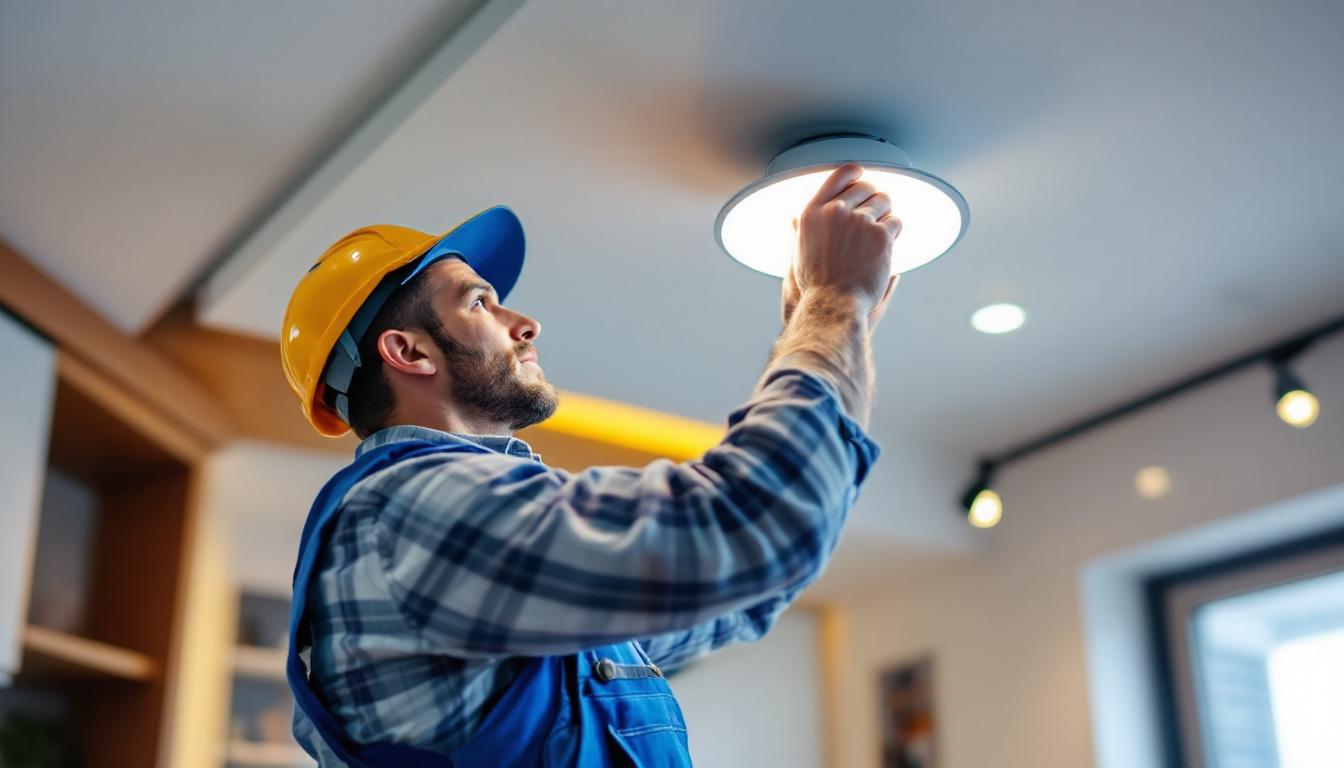
In the world of lighting installation, especially in the realm of signage, contractors often face a myriad of challenges. While expertise in lighting design and installation is crucial, common mistakes can lead to costly errors and dissatisfied clients. Understanding these pitfalls can help contractors enhance their services and improve client satisfaction. This article delves into some of the most frequent missteps made by lighting contractors and offers insights on how to avoid them.
One of the most significant mistakes that lighting contractors make is diving into a project without adequate planning and design. This oversight can lead to inefficient lighting solutions that fail to meet the client’s needs.
A thorough site assessment is essential before any installation begins. Contractors often overlook this crucial step, which can result in miscalculations regarding the type and amount of lighting required. Factors such as the location, surrounding environment, and intended use of the sign should be carefully evaluated. A detailed assessment helps in selecting the appropriate fixtures and determining the optimal placement for maximum visibility. Additionally, understanding the local climate and weather patterns can influence the choice of materials and fixtures. For instance, areas prone to high winds or heavy rainfall may require more robust lighting solutions that can withstand the elements, ensuring longevity and reliability.
Every client has unique requirements and preferences. Failing to engage with clients during the design phase can lead to misunderstandings and dissatisfaction. It is vital to listen to their vision and incorporate their feedback into the design process. This collaboration not only enhances the final product but also builds trust and rapport with clients. Moreover, understanding the client’s brand identity and target audience can significantly influence the lighting design. For example, a trendy boutique may benefit from warm, inviting lighting that creates a cozy atmosphere, while a corporate office might require bright, focused lighting to enhance productivity. By aligning the lighting design with the client’s overall branding strategy, contractors can create spaces that not only illuminate but also resonate with the intended audience, ultimately driving engagement and enhancing the client’s business objectives.
The selection of lighting fixtures plays a crucial role in the overall effectiveness of a signage project. Many contractors make the mistake of opting for generic or unsuitable fixtures that do not align with the project’s objectives.
In an age where sustainability is paramount, choosing energy-efficient lighting options is essential. Contractors often default to traditional lighting solutions without considering modern alternatives like LED fixtures. LEDs not only consume less energy but also have a longer lifespan, ultimately saving clients money in the long run. Ignoring energy efficiency can lead to higher operational costs and a negative environmental impact.
Moreover, the transition to energy-efficient lighting can significantly enhance the aesthetic appeal of the signage. For example, LEDs come in a variety of color temperatures, allowing for greater flexibility in design. This means that contractors can create a more inviting atmosphere that resonates with the target audience. Additionally, energy-efficient lighting can often be integrated with smart technology, enabling features such as dimming and automated controls that further optimize energy use and enhance the user experience.
Different materials react differently to various types of lighting. For instance, using overly bright lights on translucent materials can cause glare and wash out the colors. Contractors must ensure that the chosen fixtures complement the materials used in the signage. This consideration will enhance visibility while maintaining the integrity of the design.
Furthermore, the texture and finish of the signage materials can also influence how light interacts with them. Matte finishes may absorb light differently than glossy surfaces, which can create unexpected visual effects. Understanding these nuances is essential for achieving the desired impact. By conducting thorough tests and evaluations, contractors can select fixtures that not only illuminate but also enhance the characteristics of the materials, ultimately leading to a more cohesive and visually striking signage project. This attention to detail can set a project apart in a competitive market, making it memorable and effective in conveying its message.
Even the best lighting design can fall flat if installation is not executed correctly. Mistakes during the installation process can lead to functional issues, safety hazards, and additional costs. The aesthetic appeal of a well-designed lighting scheme can be overshadowed by the consequences of improper installation, making it essential to approach each project with diligence and care.
Safety should always be a top priority in any installation project. Contractors sometimes rush through installations, overlooking essential safety protocols. This negligence can result in accidents or injuries, potentially leading to legal repercussions. It is crucial for contractors to adhere to local codes and regulations, ensuring that all installations are safe and compliant. Furthermore, educating clients about these safety standards can foster a sense of trust and transparency, reinforcing the importance of professional installation practices.
In addition to adhering to safety regulations, it is vital to conduct thorough risk assessments before beginning any installation. This proactive approach enables contractors to identify potential hazards and implement appropriate measures to mitigate them. Providing adequate training for all personnel involved in the installation process can also significantly reduce the likelihood of accidents, ensuring that everyone is well-versed in safety protocols and emergency procedures.
Electrical connections are the backbone of any lighting installation. Poor wiring practices can lead to flickering lights, short circuits, or even fire hazards. Contractors must ensure that all wiring is done correctly and that connections are secure. Regular inspections and testing of electrical systems should be part of the installation process to catch any potential issues early. Utilizing high-quality materials and components can also enhance the reliability and longevity of the installation, preventing costly repairs down the line.
Moreover, understanding the specific requirements of different lighting fixtures is essential for proper installation. For instance, LED lights may require different wiring configurations compared to traditional incandescent bulbs. By staying informed about the latest technologies and their installation needs, contractors can avoid common pitfalls and ensure that each lighting system operates efficiently. Additionally, providing clients with maintenance tips and guidelines can empower them to take an active role in preserving the integrity of their lighting systems, further reducing the risk of future issues.
Lighting systems require ongoing maintenance to function optimally. A common mistake among contractors is neglecting to discuss maintenance plans with clients.
After installation, clients should be equipped with clear instructions on how to maintain their lighting systems. This includes information on cleaning, replacing bulbs, and troubleshooting common issues. Failure to provide this guidance can lead to premature system failure and increased costs for clients.
Offering long-term support and service can set a contractor apart from competitors. Many contractors make the mistake of viewing their relationship with clients as transactional, focusing solely on the installation. Establishing a support system for ongoing maintenance and troubleshooting can foster lasting relationships and encourage repeat business.
While functionality is essential, aesthetics should not be overlooked in lighting design. Many contractors focus solely on the technical aspects, neglecting how the lighting enhances the overall appearance of the signage.
The primary purpose of signage is to attract attention. Contractors must consider how lighting can create visual impact and draw the eye. This involves selecting the right color temperatures, intensities, and angles to ensure that the signage stands out, especially in low-light conditions.
The surrounding environment plays a significant role in how signage is perceived. Lighting contractors should assess how the sign will look in different lighting conditions and from various distances. This evaluation helps in making informed decisions about fixture placement and brightness levels, ensuring the signage is effective at all times.
Effective communication is the cornerstone of any successful project. Many contractors struggle with miscommunication, leading to misunderstandings and unmet expectations.
Contractors often underestimate the time required for a project, leading to rushed installations and compromised quality. It is vital to set realistic timelines and keep clients informed of any changes. Transparent communication regarding project milestones helps manage client expectations and fosters trust.
After the installation is complete, following up with clients is crucial. Many contractors make the mistake of disappearing after the job is done. A simple follow-up call or email can provide clients with an opportunity to express any concerns or ask questions. This practice not only enhances customer satisfaction but also opens the door for future projects.
The lighting industry is constantly evolving, with new technologies and trends emerging regularly. Contractors who fail to stay informed risk falling behind their competitors.
Advancements in lighting technology, such as smart lighting systems and automated controls, can greatly enhance the functionality and appeal of signage. Contractors should invest time in learning about these innovations and consider how they can be incorporated into their projects. Embracing new technologies not only improves service offerings but also positions contractors as industry leaders.
Design trends can significantly impact client preferences. Contractors should keep an eye on current trends in signage and lighting design to ensure they are offering contemporary solutions. This awareness can help in creating more appealing and relevant designs that resonate with clients and their target audiences.
In the competitive landscape of lighting contracting, avoiding common mistakes can make a significant difference in project outcomes and client satisfaction. By prioritizing proper planning, selecting suitable fixtures, ensuring safe installations, and maintaining effective communication, contractors can enhance their service quality and build lasting relationships with clients.
Staying informed about industry trends and technologies is equally important. As the lighting industry continues to evolve, adapting to new advancements will not only improve service offerings but also position contractors as trusted experts in their field.
Ultimately, a commitment to excellence and attention to detail will set successful lighting contractors apart from the rest. By learning from common mistakes and striving for continuous improvement, contractors can achieve greater success and satisfaction in their projects.
Don’t let common mistakes dim the success of your lighting projects. At LumenWholesale, we provide lighting contractors with the superior, spec-grade lighting products you need to outshine the competition. With our unbeatable wholesale prices and no middleman markups, you can light up your projects with confidence and cost-efficiency. Our commitment to quality and affordability, coupled with free shipping on bulk orders, ensures that you never have to compromise on performance or price. Elevate your lighting installations today and experience wholesale lighting at the best value with LumenWholesale.

Discover cost-effective solutions for illuminating your bathroom with expert insights from lighting contractors.

Discover the advantages of monument lighting in Baltimore for lighting contractors, from enhancing cityscapes to boosting business opportunities.

Discover the top strategies lighting contractors use to install wafer light brackets efficiently and effectively.

Discover the key benefits and features of 150-watt LED lamps that every lighting contractor should know.